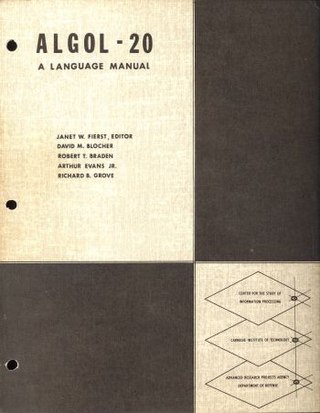
ALGOL is a family of imperative computer programming languages originally developed in 1958. ALGOL heavily influenced many other languages and was the standard method for algorithm description used by the Association for Computing Machinery (ACM) in textbooks and academic sources for more than thirty years.
In computing, a compiler is a computer program that translates computer code written in one programming language into another language. The name "compiler" is primarily used for programs that translate source code from a high-level programming language to a low-level programming language to create an executable program.

In computer programming, a macro is a rule or pattern that specifies how a certain input should be mapped to a replacement output. Applying a macro to an input is known as macro expansion. The input and output may be a sequence of lexical tokens or characters, or a syntax tree. Character macros are supported in software applications to make it easy to invoke common command sequences. Token and tree macros are supported in some programming languages to enable code reuse or to extend the language, sometimes for domain-specific languages.

Niklaus Emil Wirth was a Swiss computer scientist. He designed several programming languages, including Pascal, and pioneered several classic topics in software engineering. In 1984, he won the Turing Award, generally recognized as the highest distinction in computer science, "for developing a sequence of innovative computer languages".
Pascal is an imperative and procedural programming language, designed by Niklaus Wirth as a small, efficient language intended to encourage good programming practices using structured programming and data structuring. It is named after French mathematician, philosopher and physicist Blaise Pascal.
SNOBOL is a series of programming languages developed between 1962 and 1967 at AT&T Bell Laboratories by David J. Farber, Ralph E. Griswold and Ivan P. Polonsky, culminating in SNOBOL4. It was one of a number of text-string-oriented languages developed during the 1950s and 1960s; others included COMIT and TRAC.

Turing is a high-level, general-purpose programming language developed in 1982 by Ric Holt and James Cordy, at University of Toronto in Ontario, Canada. It was designed in order to help students taking their first computer science course learn how to code. Turing is a descendant of Pascal, Euclid, and SP/k that features a clean syntax and precise machine-independent semantics.
In computer science, a compiler-compiler or compiler generator is a programming tool that creates a parser, interpreter, or compiler from some form of formal description of a programming language and machine.
JOVIAL is a high-level programming language based on ALGOL 58, specialized for developing embedded systems. It was a major system programming language through the 1960s and 1970s.
BLISS is a system programming language developed at Carnegie Mellon University (CMU) by W. A. Wulf, D. B. Russell, and A. N. Habermann around 1970. It was perhaps the best known system language until C debuted a few years later. Since then, C became popular and common, and BLISS faded into obscurity. When C was in its infancy, a few projects within Bell Labs debated the merits of BLISS vs. C.
A system programming language is a programming language used for system programming; such languages are designed for writing system software, which usually requires different development approaches when compared with application software. Edsger Dijkstra refers to these languages as machine oriented high order languages, or mohol.
ALGOL 60 is a member of the ALGOL family of computer programming languages. It followed on from ALGOL 58 which had introduced code blocks and the begin and end pairs for delimiting them, representing a key advance in the rise of structured programming. ALGOL 60 was one of the first languages implementing function definitions. ALGOL 60 function definitions could be nested within one another, with lexical scope. It gave rise to many other languages, including CPL, PL/I, Simula, BCPL, B, Pascal, and C. Practically every computer of the era had a systems programming language based on ALGOL 60 concepts.
XPL, for expert's programming language is a programming language based on PL/I, a portable one-pass compiler written in its own language, and a parser generator tool for easily implementing similar compilers for other languages. XPL was designed in 1967 as a way to teach compiler design principles and as starting point for students to build compilers for their own languages.
ALGOL 58, originally named IAL, is one of the family of ALGOL computer programming languages. It was an early compromise design soon superseded by ALGOL 60. According to John Backus
The Zurich ACM-GAMM Conference had two principal motives in proposing the IAL: (a) To provide a means of communicating numerical methods and other procedures between people, and (b) To provide a means of realizing a stated process on a variety of machines...

CMS-2 is an embedded systems programming language used by the United States Navy. It was an early attempt to develop a standardized high-level computer programming language intended to improve code portability and reusability. CMS-2 was developed primarily for the US Navy’s tactical data systems (NTDS).
The U.S. Navy Electronics Laboratory (NEL) was created in 1945, with consolidation of the naval radio station, radar operators training school, and radio security activity of the Navy Radio and Sound Lab (NRSL) and its wartime partner, the University of California Division of War Research. NEL’s charter was “to effectuate the solution of any problem in the field of electronics, in connection with the design, procurement, testing, installation and maintenance of electronic equipment for the U.S. Navy.” Its radio communications and sonar work was augmented with basic research in the propagation of electromagnetic energy in the atmosphere and of sound in the ocean.
In computer science, bootstrapping is the technique for producing a self-compiling compiler – that is, a compiler written in the source programming language that it intends to compile. An initial core version of the compiler is generated in a different language ; successive expanded versions of the compiler are developed using this minimal subset of the language. The problem of compiling a self-compiling compiler has been called the chicken-or-egg problem in compiler design, and bootstrapping is a solution to this problem.

In computing, a compiler is a computer program that transforms source code written in a programming language or computer language, into another computer language. The most common reason for transforming source code is to create an executable program.
In computer programming, self-hosting is the use of a program as part of the toolchain or operating system that produces new versions of that same program—for example, a compiler that can compile its own source code. Self-hosting software is commonplace on personal computers and larger systems. Other programs that are typically self-hosting include kernels, assemblers, command-line interpreters and revision control software.





